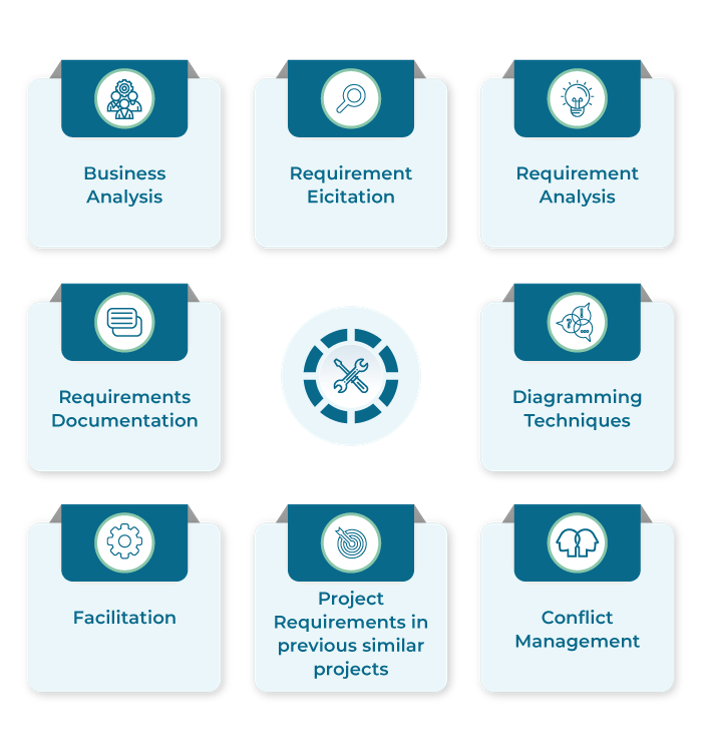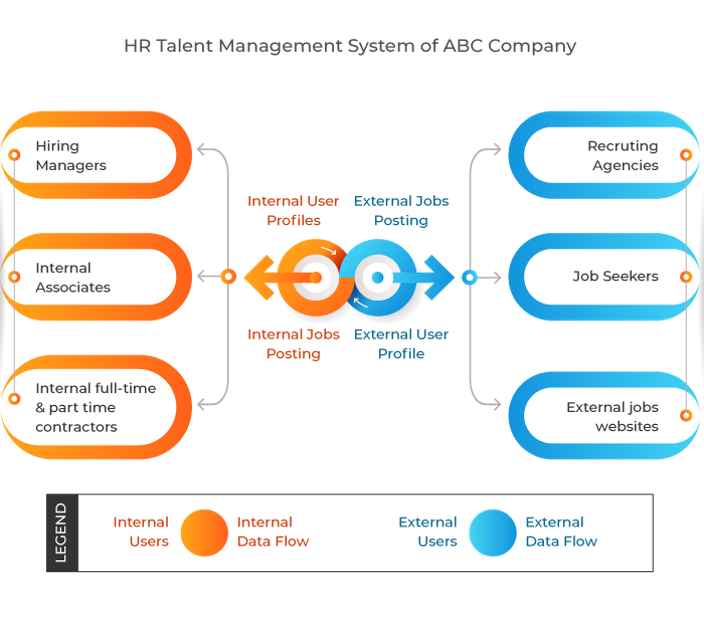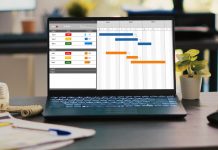
Requirements can be classified into various types, like business requirements, solution requirements, stakeholders requirements, transition requirements, quality requirements, etc. Stakeholders play an essential role in influencing the success of the project as they involve in determining, documenting, and managing the requirements. Requirements are regarded as the foundation of the WBS (Work Breakdown Structure) and for the project managers to work on a particular project would find it difficult without a requirement document because they won’t have anything to work on. We will learn about the collection requirement process in this article.
What is the Collect Requirements process?
The collection requirement is a process that determines, as well as documents, and manages the needs and requirements of the stakeholders, to meet the objectives of the Project Management task. The documentation that takes place within the collection requirement process is considered important as it provides the foundation for defining and managing the scope of the project.
The collect requirements document contains details about the objectives that are needed to satisfy stakeholders’ requirements and also to ensure project satisfaction. The collect requirement acts as a framework that provides a baseline for the project’s budget, schedule, quality specifications, risk, and resources plan.
Collection Requirement Process
An essential aspect of the project is the collect requirements process, which helps to define project scope during scope management. With some set of tools and techniques to gather requirements for projects, it’s the responsibility of a project manager to ensure capturing all the requirements. As a project manager, it’s essential to be very agile while collecting requirements, and also it is necessary to use appropriate requirement-gathering tools during the project life cycle. Ensuring not to miss any requirements of the project outcome, a project manager is liable for the success of the project.
Further, in this article, you’ll understand the requirements gathering techniques in detail.
What is the Project Requirement?
The requirements in a project are the expectation of project stakeholders on its outcomes. According to PMI, “collect requirement is the process of determining, documenting, and managing stakeholder needs & requirements to meet project objectives.”
Collection Requirement Process: The Foundation for Project Scope Definition
Step 1: Identify the needs of the stakeholders.’
Step 2: Document the needs & requirements.
Step 3: Manage them throughout the project to meet project goals.
According to PMI, about 70% of the project’s failure is attributed to requirement collection. While most of these projects were meeting schedule & budget criteria, they failed to meet the stakeholder’s requirements. This product conflict was observed during the final project delivery or project closure phase. This process impacts negatively project success!
Collect Requirements Tools and Techniques
The following are included as the tools and techniques in the collection requirements process:
- Expert Judgement
- Data Gathering
- Data Analysis
- Decision Making
- Data Representation
- Interpersonal & Team Skills
- Context Diagram
- Prototypes
Let’s take a look at each of them in detail.
Expert Judgment
Listed below are the topics in which the individuals or groups should have specialized knowledge and expertise:
Data Gathering
Data gathering techniques that can be used for the Collecting Requirements process are :
-
- Brainstorming
A group thinking activity, where several people from various teams come together to list requirements for a project. And during the brainstorming session, new ideas are generated from existing plans, which helps to identify new requirements. - Interviews
It is the first collect requirements technique. It can be done in both formal and informal ways. The critical feature of this process is that it helps the project manager to interview experienced project participants, sponsors, stakeholders and other executives, and subject matter experts who can aid in identifying and defining the features and functions of the desired product deliverables. - Focus Groups
The focus groups bring together pre-qualified stakeholders and subject matter experts to learn about their expectations and attitudes about a proposed project. The Focus Group is a technique used to get a specific set of stakeholders’ requirements. For instance, first, the project manager can organize a meeting with the executive directors of a company to get their requirements, and then arrange a separate meeting with the functional managers to understand their requirements. - Questionnaires and Surveys
This technique is best used when there are more stakeholders involved in a project. For example, if there are 200 stakeholders associated with the project, collecting information from each individual to assess their requirements will consume a lot of time. Hence, the project manager is requested to prepare a questionnaire and conduct surveys to collect their requirements list. - Bench-marking
It is a process that is used to compare the actual or planned practices – procedures and operations, to those of comparable organizations (internal or external) to identify best practices, generate ideas for improving the scope, and provide a framework for measuring the actual performance.
- Brainstorming
Data Analysis
Data analysis mainly deals with the processes that are related to document analysis. The primary purpose of document analysis is to review and assess all the relevant document information. This process is used to obtain requirements by carefully analyzing the existing documents and identifying relevant details on the requirements.
Various documents are analyzed to help bring out the necessary information for the required process, and they are as follows:
Decision Making
The decision-making techniques that can assist in the Collect requirement process are :
- Voting
It is the collective decision-making technique and an assessment process that has various alternatives with a defined outcome. These techniques are further used to generate, classify, and prioritize product requirements. Listed below are the examples of voting techniques:
-
-
- Unanimity: Unanimity is a decision that is reached whereby everyone agrees on a single course of action. One effective way to achieve accord is the Delphi technique, in which a selected group of experts and stakeholders answer questionnaires and provide their feedback regarding the questions asked which cover all the areas of the project. These responses are resent to the decision-makers to and fro until a consensus is reached among the stakeholders.
- Majority: The suggestions or ideas that are gathered from the experts are chosen based on the majority of people backing the process. This will allow the project manager to select and implement the best ideas to achieve the requirements.
- Plurality: A decision is finalized based on the opinion of the most significant group in the organization, even when there is no room for a decision based on the majority.
-
- Autocratic Decision Making
As the title states, the decision is taken by a single individual who has the ultimate authority in the organization. - Multi-criteria Decision Analysis
A technique in which a decision matrix is used to provide a systematic and analytical approach for determining criteria such as risk levels, uncertainty, and valuation, to evaluate and rank many ideas.
Data Representation
The data representation techniques that can be used for the process of collecting requirements are as follows:
-
- Affinity Diagram
A technique where all the ideas that are collected or gathered are segregated accordingly based on their similarities - Idea/Mind Mapping
The ideas that are generated through the brainstorming sessions are consolidated into a single map to filter out the conventional concepts and understand the differences in opinions which will help in developing new plans.
- Affinity Diagram
Interpersonal and Team Skills
The interpersonal and team skills techniques that can be used for the process of collecting requirements are as follows:
-
- Nominal Group Technique
The technique uses skills to prioritize the already existing ideas rather than developing new ideas. In this process, the plans are ranked based on their value, and this helps the teams to focus on the essential concepts to generate the project requirements. - Observations
Also known as ‘Job Shadowing’, Observation is a process where an observer views a business expert performing his job. This process is mainly to strictly observe the activities taking place across various areas to find out what are the actual requirements of the consumer, stakeholder, sponsor, etc. - Facilitation
It is a technique that has focused sessions that bring key stakeholders together to define product requirements. In general, each group of project stakeholders will look at the project from their very own perspective and express their requirements. Workshops are considered a primary technique for quickly defining cross-functional requirements and reconciling stakeholder differences.
- Nominal Group Technique
Context Diagram
To have actual knowledge of understanding the scope, the context diagram provides an example of the scope model, which will allow the project manager to visualize how a business system (Process, Equipment, and Computer systems) will work. This process is used to find out how the business system and the other users interact with each other.
Prototypes
The technique, which involves the process of creating a model of the actual product, is to be achieved. The team will build this model of the product and pass it on to the stakeholders for collecting their feedback. As the model is a tangible product, the stakeholders can check it thoroughly and request changes if they find any, instead of waiting until the end by only sharing and discussing abstract representations and ideas.
Collect Requirements Process Inputs
The following are included as the inputs for the collection requirements process:
- Project Charter
- The Project Management Plan
- Project Documents
- Business Documents
- Agreements
- Enterprise Environmental Factors
- Organizational Process Assets
Let’s learn more about them in detail.
Project Charter
To develop the detailed requirements of the project, the project manager uses the high-level description derived from the project charter to determine the scope of the product.
The Project Management Plan
Project Management Plan includes the following components;
-
- Scope Management Plan
As the scope management plan determines the essential and valuable aspects of a project, it will provide clarity to the project teams to decide on which type of requirements are to be collected for the project. - Requirements Management Plan
The main priority of the project manager is to define and document the needs of the stakeholder. The requirements management plan plays a crucial role in providing the methods/processes that can be used throughout the collect requirements process to help the project managers achieve these needs. - Stakeholder Management Plan
It is understood that the stakeholder is an integral part of the project. The stakeholder management plan is used by the project manager to understand the stakeholder communication requirements and their level of engagement to assess and adapt to meet their level of participation in achieving requirement activities.
- Scope Management Plan
Project Documents
The inputs that can be considered under project documents are listed as below :
-
- Assumption Log
The process of assumption log identifies the assumptions regarding the product, project, stakeholders, environment, and other essential factors that can influence the outcome of a particular project. - Lessons Learned Register
The lesson learned process is used to provide information about the effective requirements collection techniques which especially use an adaptive and iterative product development methodology. - Stakeholder Register
Identifying the key stakeholders of a project is an important task, as they provide information on the requirements of a project. This identification process is made simpler with the use of the stakeholder register. The register helps in capturing the significant needs and primary expectations of the stakeholders that relate to the project.
- Assumption Log
Business Documents
The business case is what influences the technique of business documents under the collect requirements process. This particular technique can be used to describe the required, desired, and optional criteria necessary to meet the business needs.
Agreements
The Agreements technique is used to collect information about the project and the product requirements necessary for the completion of a particular project.
Enterprise Environmental Factors
The enterprise environmental factors which can influence the Collection Requirements Process are as follows – Organization’s culture, Infrastructure, Personnel administration, and Marketplace condition.
Organizational Process Asset
A project’s policies, procedures, historical information, and the lesson learned repository which includes information from the previous project’s success and the organizational process assets that influence the Collection requirements process.
Collect Requirements Outputs
The following are included as the outputs in the collect requirements process:
- Requirements Documentation
- Requirements Traceability Matrix
Let’s deep dive and learn about them in detail.
Requirements Documentation
A technique that describes how individual requirements meet the business need for the project. The requirements may start out at a high level and become progressively more detailed as more information about the requirements is available.
Even before the requirements can be listed down in the project plan, they need to be unambiguous, traceable, complete, consistent, and acceptable to the key stakeholders. The requirements document may take different forms.
It can be a simple document listing all the requirements categorized by stakeholders and priority, to more elaborate forms containing a detailed summary, description, and attachments.
Components of Requirements
- Business Requirements
-
- The Business and project objectives for traceability
- Business rules for the performing organization
- Guiding the principles of the organization
-
- Stakeholder Requirements
-
- Keeping a note of the impacts that the stakeholder’s requirements might have on other organizational areas
- Noting how the stakeholder’s requirements might impact entities inside or outside the performing organization
- Stakeholder communication and reporting requirements
-
- Solution Requirements
-
- Providing solutions for functional and non-functional requirements
- Providing solutions to meet the technological and standard compliance requirements
- Solutions that provide Support and training requirements
- Providing solutions that maintain the Quality requirements
- Solution requirements that can be documented textually, in models, or both
-
- Project Requirements
-
- Requirements based on the levels of service, performance, safety, compliance, etc
- Those requirements that are approved and come under the acceptance criteria
-
- Transition Requirements
- Requirements assumptions, dependencies, and constraints
Requirements Traceability Matrix
The Requirements Traceability Matrix is a document that links requirements throughout the validation process. The purpose of the Requirements Traceability Matrix is to ensure that all requirements defined for a system add business value by connecting it to the business and project objectives.
It’s a process that provides a way to track requirements throughout the project life cycle, helping to ensure that requirements approved in the requirements documentation are delivered at the end of the project. Finally, it provides a structure for managing changes to the product scope.
The various kinds of tracing processes that are conducted under the Requirements Traceability Matrix stage:
- Business Needs
The project manager should maintain track of all the business needs that are required to be accomplished.
- Project Objectives
It is imperative that the project manager keeps track of the project objectives in an attempt to ensure that they are achieved in due process.
- Project Scope/WBS Deliverables
The project manager should always maintain track of the project scope. If the project scope deviates, the deliverables might not be achieved.
- Product Design
To efficiently accomplish the undertaken project, the project manager has to trace the path of the product design, as it was finalized and given approval by all the key stakeholders involved in the project.
- Product Development
Tracing the development to ensure that the project has achieved its desired scope at every stage of the project life cycle.
- Test Strategy and Test Scenarios
A proper procedure has to be developed to test the product after execution, and also the project manager has to conduct test scenarios through which the product has to be correctly tested to produce the required deliverables.
- High-level Requirements for More Detailed Requirements
The project manager can’t consider all the requirements to have the same scope, there would exist high-level requirements that garner more scope. So, to satisfy these requirements, the project manager has to allocate more requirements to such components.
Project Manager’s Role in Collecting Requirements
As project managers, ensure that you are well versed in the following requirements management processes:
Planning
Describes how each phase of the requirements gathering process will occur. The best recommendation for project managers is to develop and share the plan document to minimize confusion and ensure that all stakeholders are on the same page.
Identification
This process begins with identifying all the stakeholders and understanding their organizational needs. Project Managers have to utilize their skills and decision to determine the most appropriate method to obtain this information such as one-on-one interviews, focus groups, questionnaires, or ‘use cases.’
Documentation
If the business requirements and their approval are not documented with sufficient detail, project managers have to be relying on recollection and project insights. This can be risky. It is imperative to document all requirements and apply a unique ID number to each one so that it can be easily referenced and traced throughout the process. Using a process flow chart or diagram to demonstrate various “use cases” can be extremely helpful in thinking through a process and mapping out how the user will interact with the new process. It also helps to demonstrate the “benefit” of the new process/system.
Analysis
At times stakeholders have unrealistic expectations for any new system. Since every project has a budget and other constraints, careful analysis must be performed to determine the cost, relevance, dependencies, and resources required to achieve each requirement.
Prioritizing
The data generated from the analysis phase will help to prioritize requirements. Project Managers should always ensure that the prioritization and linked authorization of requirements are documented. One step that’s often missed during this phase is communicating with stakeholders to set their expectations. So, prioritize the requirements that have to be implemented in projects.
Control
When you think you’re done with requirements identification and have obtained the approvals, some requirements may need to change. Given the constraints like budget and time, how will your Project Manager handle or control changing requirements?
Approval
The Project Manager’s role is to know who has the final say on all project requirements and to document every approval in writing. Seasoned Project Managers can overcome obstacles associated with requirements gathering and will serve as a link between the end-users and the team that develops the new system, product, or database.
What is Involved in Collecting Requirements for a Project?
Collecting requirements involve defining and documenting the features and functions of the products that are initiated and delivered during the project processes used for creating them. The project team also creates requirements documentation and a requirement traceability matrix as outputs of the requirements collection process. Interviewing stakeholders, questionnaires, and surveys are also involved in collecting requirements for a project.
For projects that are related to IT, it is helpful to divide requirements development into categories called elicitation, analysis, specification, and validation. It is essential to use an iterative approach to defining requirements since they are often unclear early in a project.
Why is Collecting Requirements Often Difficult To Do?
Collecting requirements are more straightforward than it seems to be. But most project failures can be traced back to faulty requirements. Although projects include the gathering of requirements, here are a few reasons why it is difficult to collect requirements.
- Work underestimation
- Unknown requirements
- Relying on users
- Analysis paralysis
- Inadequate requirements
Conclusion
Collect Requirements is an essential process because if the requirements from the stakeholders are not collected properly, the scope of the project may risk being faulty. Suitable techniques to gather requirements are selected and implemented by the project manager to have successful scope management. Every detail is considered important in judging and finalizing the main requirements. At this point, the skills and best practices can exponentially benefit the project and the deliverables. So give yourself a chance to enhance your Project Management skills with PMP certification training, and excel in your career.
Know more about Project Management best practices through Invensis Learning’s Project Management certification training on PMP Certification Online Training Course, CAPM Certification Training, Prince2 Foundation and Practitioner Online, Project Management Fundamentals, etc.


















